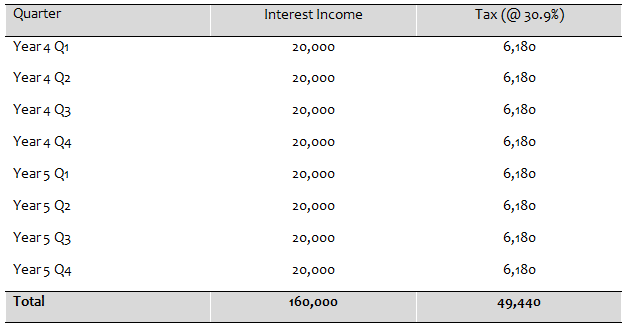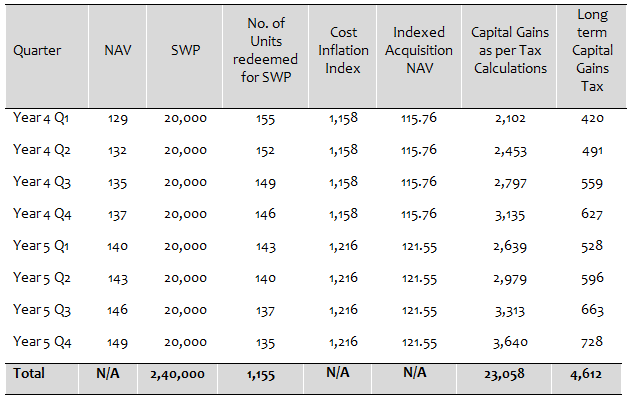SWP from Debt Mutual Funds give the most tax efficient income over fixed deposits

Yesterday we discussed in the first part of this article how the Debt Mutual Funds Systematic Withdrawal Plans give the most tax efficient income in comparison to fixed depsoits.
In the above post, we discussed, prior to 2014 debt fund returns from investments held for less than 12 months was taxed as per the income tax rate of the investor and how it changed from more than 1 year to more than 3 years during Finance Minister Arun Jaitley’s first Budget in 2014. Long term capital gains prior to 2014 were taxed at 10% without indexation and 20% with indexation. After the 2014 NDA Government budget, the period for long term capital gains taxation was increased from more than 1 year to more than 3 years. Currently, capital gains from debt fund investments held for less than three years are taxed as per the income tax rate of the investor. For debt fund investments held for more than three years, returns (long term capital gains) are taxed at 20% after allowing for indexation benefits.
Today, in this article, we will discuss how Debt Mutual Funds long term capital gains is more beneficial than short term capital gains in debt mutual funds. It gives the most tax efficient returns for investments held for more than three years.
Taxation of long term capital gains from debt funds versus fixed deposit interest
There is no difference in tax treatment of fixed deposit interest over investment tenures. Fixed deposit interest, as discussed, is taxed at the income tax rate of the investor. Therefore, even after three years, Richa continues to pay the same income tax. The table below shows her tax obligations.

However, for debt mutual funds the tax treatment for long term capital gains is more beneficial than short term capital gains. Long term gains from debt funds are taxed at 20% after allowing for indexation benefits. What is indexation benefit? You are allowed to index to the acquisition cost of your debt mutual fund units by the ratio of cost inflation index in the year of redemption and year of acquisition. Suppose cost inflation index in the year of Pooja’s investment is 1,000 and that in the 4th year of her SWP will be 1,157. For the purpose of long term capital gains calculation, Pooja will be allowed to index her purchase price by the ratio of the 4th year Cost Inflation Index and her investment year Cost Inflation Index. Remember the NAV of the debt fund at the time of Pooja’s investment was 100. To calculate her long capital gains tax, her purchase NAV will be deemed to be 115.7 (100 multiplied by the ratio of 1,157 and 1,000). Therefore, you can see that her profit for the purpose of tax calculation will be much lower than what her actual profit is. The inflation rate is around 5%. In this example, we have assumed the cost of inflation index to grow at 5% every year. The table below shows the long term capital gains tax of Pooja.

You can see that, Pooja will pay much less tax than Richa once long term capital gains kick in. In fact, Pooja’s tax advantage relative to Richa increases in percentage terms after year 3. However, you would have observed that Pooja’s tax obligation in Year 5 is higher than that of Year 4. Her tax obligation will keep increasing every year while Richa’s tax obligation will remain the same. But Pooja’s tax obligation will increase at a slow pace because she will get indexation benefits. In fact, Pooja will continue to pay much less tax than Richa for many years. Less tax means more disposable income for Pooja and more cash to meet her lifestyle needs, as well as meet any unforeseen expenditure. She can even re-invest some of the money she saved in taxes for future needs. In our analysis, we had assumed no exit load for Pooja. Exit load will not make any material difference to the final results. Even if Pooja pays an exit load of 1% on her first year र 80,000 withdrawals, her loss is only र 800. She saved much more in taxes. But why should you pay any exit load? To avoid exit load, you should start your SWP after the exit load period of the fund. To meet your expenses during the exit load period, put the required amount in a liquid fund (which has no exit load) and draw monies, as and when you need them.
It is important to note that, Pooja’s mutual fund investment is subject to market risk and therefore her investment value may have some volatility. Richa’s capital on the other hand is totally protected. But the notion of capital protection is sometimes questionable. If Richa is faced with a large unforeseen expenditure at some point of time in the future, she will have to liquidate a portion of her investment. On the other hand, the perception of risk is not binary. There are different grades of risk or volatilities. Different debt fund categories have different grades of risk. We have discussed the risk return characteristics of different types of debt funds in our post, Demystifying Debt Mutual Funds.
Conclusion
In this post, we have discussed that systematic withdrawal plans in debt mutual funds can give the most tax efficient income, not just during the long term capital gains tax period, but also during the short term capital gains tax period. Tax efficiency should be an important consideration for all investors, but it is especially important for retired investors who rely on investment to meet their post retirement income needs. Investors should consult with their financial advisors, if SWP or systematic withdrawal plan in debt mutual funds is suitable for their financial needs.
RECOMMENDED READS
- Combination of Home Loan EMI and Mutual Fund SIP can save you lot of money
- Systematic Withdrawal Plans from Debt Mutual Funds give the most tax efficient income
- How to select the right debt mutual funds for your portfolio: Part 1
- How to select the right debt mutual funds for your portfolio: Part 3
- Mutual Fund ELSS schemes: best way to save tax and create wealth
LATEST ARTICLES
- Different types of diversified equity mutual funds: Schemes from Principal MF stable
- Principal Equity Savings Fund: For investors who look for regular income and capital appreciation
- Regular Withdrawal Plan: A smart and convenient way of getting regular income
- Mutual Fund ELSS schemes: best way to save tax and create wealth
- What are Balanced Mutual Funds
We understand what you're working for
We are committed towards helping individuals, businesses & institutional clients achieve financial security & success.
Quick Links
Product Brochures
More About Principal MF
POST A QUERY




